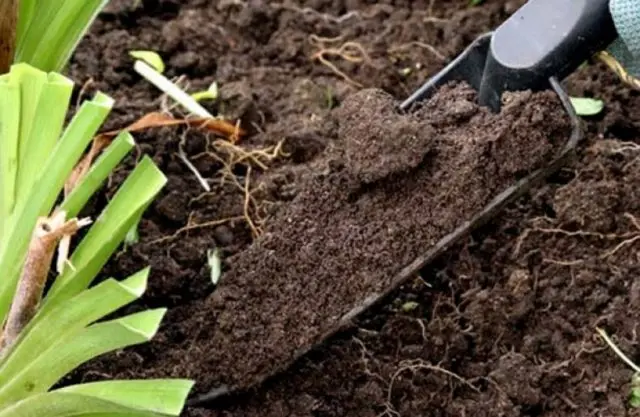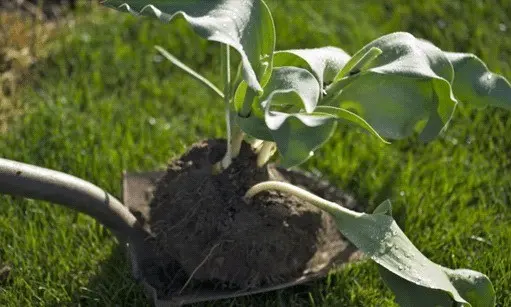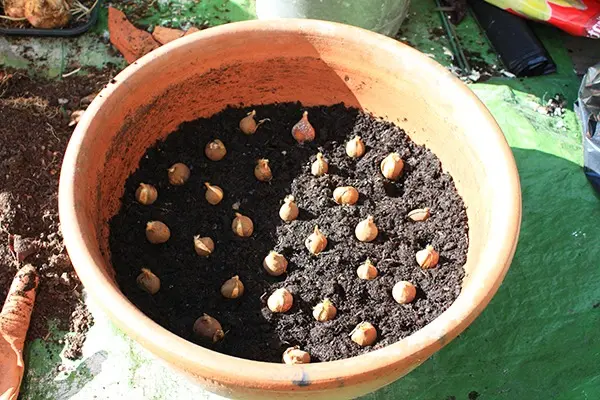Contents
Sometimes it becomes necessary to transplant tulips in the spring before flowering. This most often happens if time was missed in the fall, when this procedure is usually done. In general, there is nothing wrong with transplanting tulips in the spring. The main thing is to carry out all the manipulations according to the rules, as well as handle the bulbs carefully and carefully, since at the beginning of the growing season the risk of damaging them increases significantly. It should be borne in mind that the flowering of tulips transplanted in the spring may not occur in the current season. It often also happens that the buds appear, but much later than the deadline. Experienced gardeners advise transplanting tulips in the spring only in exceptional cases. Basically, you should still give preference to autumn.
Is it possible to transplant tulips in spring
Transplanting tulips in the spring is certainly possible. However, the autumn option is considered preferable, since the bulbs during this period adapt better to a new place, thoroughly prepare for wintering in the ground and, germinating after the end of the cold weather, give healthy and beautiful flowers on time.
In the case when you have to organize a transplant of tulips in the spring, it should be remembered that they may not bloom in the coming summer. If buds do appear, then this will most likely happen much later than usual. And it’s better not to count on abundant, lush and decorative flowering.

It is best to transplant tulips in the fall, but you can do it in the spring if there is an urgent need.
When to transplant tulips: in spring or autumn
The timing of transplanting tulips is influenced by a number of factors.
Among them:
- climatic and weather features of the region;
- phase of plant development;
- characteristics of a particular variety (in particular, early or late flowering).
The general ideal option is usually considered to be an autumn transplant, which is done at least 30-40 days before the first snow is predicted. In central Our Country, this is usually the period from the first decade of September to mid-October. For northern areas with early winters, the optimal time is usually limited to the middle or end of September.
The possibility of transplanting tulips in spring is determined by the following rule: the temperature of the soil at a depth of 10 cm should be + 8-9 ° C. In temperate regions, this is around mid-March and early April. In the northern regions, suitable conditions can be expected longer, until the beginning of May.
It is not allowed to transplant during such periods:
- Just before flowering. If at this stage the plant needs to spend additional forces on rooting, this can lead to its weakening and general deterioration. It is best to wait for the time when the tulips have faded.
- In late autumn, at the stage of the onset of severe frosts. The bulbs will not have enough time to qualitatively prepare for wintering in the ground and the risk of their death will increase greatly.
How to transplant a blooming tulip
Transplanting tulips during flowering is highly discouraged. Such a plant will be much more difficult to take root in a new place. In addition, interference with the natural development cycle of the bulb can adversely affect the formation of sprouts and flowering for the next year.
If, nevertheless, there is a need to transplant a flowering plant, it is advised to act according to one of the following scenarios:
- Remove the tulip from the soil along with the bulb. Gently rinse it from the ground without cutting off the head, place it in water and wait until the plant fades. After that, dry the bulb in the air and send it to storage until a convenient time for planting in the ground.
- Carefully dig up the plant, along with a large clod of earth, using a garden fork or bayonet shovel. Transfer to a new, pre-prepared place, and water abundantly.

Flowering tulips do not tolerate transplanting very well, so it is best to wait until they fade
How to prepare a bulb for transplanting
For transplanting tulips in the spring, planned in advance, the material is harvested in the summer. After waiting for the end of June or the beginning of July, when the flowering ends, and the leaves and scales of the bulb turn yellow, the plants are dug out of the ground. Then they are cleaned of adhering soil, dried in a warm room for 3-4 weeks and sorted by size, rejecting damaged or rotten specimens.
After that, the bulbs are wrapped in paper with holes for aeration and stored in the vegetable compartment of the refrigerator. In the spring, a couple of weeks before the planned transplant, they are placed in wide boxes or containers filled with nutrient soil by about 15 cm. The bulbs are carefully laid out at a distance of 4-5 cm from each other, sprinkled with a layer of earth 5 cm thick and watered. 2 weeks after the emergence of sprouts, tulips are transplanted into open ground. With this approach, plants do not need long-term adaptation, they will actively develop, and flowering will begin on time.
Sometimes there is a need for an urgent transplant of tulips, it can be caused by pest damage or impoverished soil. In this case, it is undesirable to dig up the bulbs one at a time, but it is better to transfer them to a new place along with a clod of earth on the roots.

It is most convenient to transplant already rooted tulips in the spring, transferring them to another place along with a large clod of earth on the roots.
How to prepare the soil for transplanting
The site for transplanting tulips is selected according to the following criteria:
- well lit by the sun;
- protected from wind and drafts;
- with light, nutritious, neutral, well-drained soil.
It is important that the bed is not flooded after the snow melts. Ideally, it should be located on a small hill (if necessary, you can add a little soil).
In the process of digging, organic matter (humus or chopped grass) is introduced into the soil. If the acidity of the soil is increased, ash will help reduce its level. In the case when the soil is clayey, too heavy, it does not hurt to dilute it with coarse river sand. If necessary, you can enrich the earth with minerals (compositions containing nitrogen, phosphorus, potassium).
Rules for transplanting tulips
Tulips need a mandatory transplant to a new place 1 time in 3-4 years. If this is not done, then the bulbs will begin to grow, forming “children”. This will have a bad effect on flowering, plants will begin to lag behind in growth and gradually lose their inherent beauty.

If a spring transplant is planned in advance, it is best to pre-sprout the bulbs in a container indoors.
Transplanting tulips in the spring has its own characteristics. It is advisable to follow certain rules:
- It is recommended to transplant tulips in sunny, dry, calm weather.
- Mother bulbs and the “children” separated from them are best placed in separate beds, since the latter will definitely not bloom this year, since they need to grow up.
- In the soil, you need to dig grooves or individual holes. Their depth should approximately correspond to the three sizes of the bulbs that are planned to be planted. The distance between the holes should be 10-15 cm.
- Before transplanting tulips, the holes should be poured with water and wait until it is absorbed into the soil.
- Bulbs need to be carefully laid out in pits or grooves with “tails” up. Large specimens are planted one at a time, small ones can be laid out in several pieces (from 5 to 7).
- Sprinkle the bulbs with soil and carefully pour warm water.
- Level the soil in the garden.
Tips for caring for tulips after transplanting
Care after transplantation comes down to a few simple steps:
- It is necessary to regularly loosen the soil around the tulips to ensure a better supply of air and moisture to the roots. This must be done carefully so as not to damage the bulbs.
- Before flowering, tulips need moderate regular watering. After the buds appear, it is desirable to increase the amount of moisture.
- To improve the growth and manifestation of decorative qualities, tulips should be fed with complex fertilizers. Do this three times during the season: when shoots appear, shortly before flowering and after it ends.
- An obligatory stage is regular weeding in the beds with tulips. This will help the flowers stay healthy and fully receive water and nutrition from the soil.
Conclusion
If you need to transplant tulips in the spring before flowering, you should consider whether there is an urgent need for this, since the beginning of the growing season is not the best time for this procedure. In the case when this is really required, it is advisable to choose the time before the appearance of the buds, after the snow has melted and the soil has been properly warmed up. When transplanting tulip bulbs in the spring to a new place, it is necessary to handle them very carefully and carefully, since during this period they are very easy to damage. Ideally, a month before the planned rooting in the open field, it is desirable to germinate them in a container with nutrient soil. This will simplify the adaptation of the bulbs in the spring garden and will allow you to see the flowering of tulips already in the current season.









